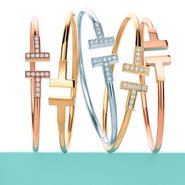The Interactive Advertising Bureau reviewed the top 100 fashion brands chosen by Women's Wear Daily's and found that jeweler Tiffany & Co. is ahead of the pack.
The report found that 83 percent of the brands have mobile-optimized sites and 37 percent use responsive Web design to ensure a seamless experience across devices. The need for a strong mobile presence is particularly acute for fashion brands that have exceptionally mobile savvy consumers.
"Fashion brands need to be particularly aware that their customers live mobile-first lives," said Joe Laszlo, senior director of mobile marketing center of excellence at IAB, New York. "When someone sees a great dress, bag or pair of shoes in real life, their first reaction (after figuring out who makes it) is likely to be grabbing their smartphone and looking up that brand or store.
"And social media — another important tool for keeping up with fashion trends — is increasingly a mobile medium as well," he said.
"So mobile is the front door for many consumers seeking information about new fashion items or brands, and delivering a great experience on the phone will smooth the way toward learning more and potentially buying that hot new item."
The "Fashion of Phones: Mobile Readiness of the Women's Wear Daily Top 100 Brands" can be accessed here.
Moving forward
Seventeen percent of the brands studied did not have a mobile-optimized Web site, which is a startling figure at this stage.
Consumers who visit a non-optimized mobile site on their phone are likely to get frustrated and go to another site, which can hamper online sales and prevent consumers from researching prior to visiting in-store.

Mobile app Spring was designed to help luxury brands with mcommerce
Plus, a non-optimized mobile site harms brand image by suggesting that the brand is incapable of meeting consumer expectations.
Among the brands without mobile-optimized sites is Versace.
Following this overview, IAB zoomed in to monitor key mobile site features including store locators, mobile-optimized search functions, tap-to-call phone numbers, links to desktop site and app store links.
Eighty-five percent of brands had a store locator and 65 percent had mobile-optimized search.
The report notes that an absence of mobile-friendly search leads to cumbersome navigation, which leads to page abandonment.
Next, IAB assigned an "M-Score" from 0-100 to each brand, which is an assessment of mobile performance. The average M-Score was 61.85.
Outliers
Many luxury brands were slow to the mobile scene, but have since adapted.
Mobile presents an opportunity for retailers to give consumers a personal, local experience when shopping, according to panelists at the Details Tech & Tastemakers Summit on Sept. 3.
Beyond serving as a channel for commerce, mobile allows brands to engage with consumers anywhere, providing advice and entertainment. As much as technology is changing shopping, when retailers plan their digital strategies, it is wise to think of how it fits into the larger customer shopping experience (see story).
However, before brands can take steps forward, they have to set a foundation.
"The big surprise from this study was that in late 2014 almost 20 percent of the WWD top 100 brands don’t yet have a mobile-optimized Web site," Mr. Laszlo said.
"This list represents the best-known brands in fashion, and while many of them are doing mobile really well, the fact that some of them are barely doing mobile at all suggests misplaced priorities and risks missed opportunities to win fans and make sales," he said.
Final Take
Joe McCarthy, staff writer on Luxury Daily, New York
{"ct":"oJY9QgKSJXdkS6ZVzakVLIlZexsF+gi\/IWanZQh9kvwoXt52CZhT5AwIqc+Yh3ZolJpQQr9vZFFkGYgkB27Mp1uOfGInyrxVaBu7v31swz4ZMb7cYMOjuur7KGLKAOTU+l9tumNxrrHGQ9pthsyyt\/0zMTHKL7QWTuSQ227TzuJ8E6WeX2p37AP+XXXM4i5hp5KeWkKPZel6va8Sxzpz3eHL1b0ejKd1ef\/A1TCzKqDMJ38jMx8rZvlTSejiKMGZqfOHQb0dw3PVyNWcUK3I\/I7\/A2Qrnj85tuOE13UKqsCmYhPZlPTV5OdgcnbLnR31b+vUKxmldFknRAeN5lVoJMQmTvhMgb7tseGdg0t81ScbU68RgUv5gM35u4\/KeyYEts+61MXYctMGUirhCoHwgvaAuvmIqzJjqKjaQUTBI28kCA2Z\/dWUMVm4T\/m+QVGNY9V362CWY9Ioanh9bLs+lb3iQiATymoGImG4B75XC1CX0Vw7lrRbSQpKHcCbbtyIwzs+Oc\/VQG7x4YG4SBnsL7SmjTYJfTZUZsB\/AnceoCbAn9J6k+yFhWquh31zc7PpW0AZUfERuG7eGHPE\/R46jM3r4vQkldHrV2mBzhA0+k0pisE45ku9upTVcHxPe1sP3g6nlzFUvHVqhcpLCIchGZmWYV+DZv0NDXPYVKiIN0zwIf9uu8N4eCgYhpr47GIj8F5gEjAbUlLwf0XEuxjv\/WpkpPXVyiVewnxYVbcEWF8Gwf9OCIr3f+5yPvfTZBvpDr3OBgjVBE2cr29YONtYm5DOnGyALOz\/APmVNdP6MIKz53vi6nzKE16DPF9WccBBV0CIH3FCkVRHzwV\/RDNtZcp856wCC9VztI7d9VZRq7PClh+IGylUfbfDvTHeDCphCrvbcVpZFan3cLJom0\/KR62lem+xahiyCrCAsCq2EwmJzotjKV\/POVxqze\/ZHv\/anya7J0S2m9LYrdzJZS2LmrL+BNVWRJdUMhGSnPSGRP+GVXVB2bL5uknRQjRQdchmeHeGsd+PdT1wvJ0f07XTJ8G8MhYO0UC0FroqAumGNpU3YPuWcLOon3emWMG265vfcFWlR4r1hnW3r0Hfha1OtCJOs8+SJtOv+qovwzdP8RAjyIM6MeIBWappeIHF1f5gXOLGHNYfqu1knOCNmaWrT0z68h0YBCEPOkghW39Mz\/2hiWEdyzqFwtpQVJls7J+n5LRcmwmT2hRIYstmCOjfa5IOIyNk+2TU9aYko2hWkFN+a9q9Hbc9ye36bPUNSO0aAKNSQMrvPpC1NamuEynd5pEf7YZBq6ZCR8+Vtq9dfRJvVbz5Dp2aQXh8BxctNRN4pPQnBa8tM4571GOPMPpET4gmQvjciFXdnC0SdVSCMRIjlKRex7ODXaMEDKkuRuSDX81D4vOGnsUOBfbWPLNGU73sTpYZAJOk1SB5\/cvU7M5dD9t+pNKTcsyyvtUEMaidpeSHrjGVtWBgxXK4ogo5eLaPPrdoqR3tVWiCCRZ63dnwROmARL9DT3EZC4lrc8gfcTcwtWj+3C4K\/idS5fsA+8pe8Z+OtlrfGKrHi9hGhEuF9um7dh1OI8VIwjKvFhn80FDrN1hb9htRNJIZwpx0TguAvKI9wIveacyS+TVY0izC1cjJdx8jQmzs2EQ3jpvR+5hS1xu+ouVPvQ7FwhsWHmNXq1Q80tr86lXcisp7RfScezb+\/2ZVzoyIAJeXCQhu\/tBegtsnWM27HE0ljWEffTD1GxQIfNQbRiGvAhHUdjD8SfrQEVJ7616814JE\/6H\/Qa9my7upd++kAKi8e61StBbF3st05bVsujWOwvztfjVvlyKIyVHERgxWsEQu+OQ3bUggHvEDEiUXXBGDoC0j9QiF4Yigv1mD5u+ktHhsVd3l5OUwdZ00BEA+uLdFhm1zz\/qqfZN7ChutD5nnb6OgPCpY0UxUe4zsOOJviCn9caJGEIK60vHDTDvaBb731Nliwug7zwPXf1dx59Cazl17JBa9T4SiV\/U3734lo057OUSPirEgvozPIoDN\/Z\/E6GFptyfT+RDoSFUKgQp2\/ndmIT50y6YeZU3cSdluW\/EuWu1EPTmlrOSjxkGSmo0vO0krSu3EkQPPM2i+S0UiludL6G836AGCIMprAkQ7+i+JzJaH6JhAAWzLNGv+\/Ph\/pSkj3HsofzOCPtyJjXkesYT5culAuhSlfPur55jayZfM3D2XoWS+k8VNuLEGEFivevJ0rNcTvI6MMg+wleHKwxK1bmtxrCWimN6kc7rXjgmvYgtqClIXx349Md9vyhNWJzXRwWiTC63BEUocx2qrB0fYEn\/Ffs9rJWLYfDpEI+vx6Em8czrIWM\/0Q3sR9lh7umlF\/Mwf3xQcK0GIC5zJ1q6rQ4BMBqtbAYA\/206mXG6nX9BF56R0SKI8BylRS2HGTmjibQEejnmu+5XDDs+TXF4Ysp84WwrTfwqGdVvAu8GgABN8BtCIZcucwHZxqtY32I7RVLdR1oiFYRvL4Ox6KsFS49M1BPSkFx9gwvWNvqj+p8gMD1ByKslnCvR16sz3744hEso6W7zKX8i\/PNxjN8XYr1MNeKyDqljaw73L9PZH+5Zxy5RVvuOJhK8aR4QkO9C9qz0dWmqx3S7nHRNG7LyC85L6imneCgiqRZeGqgMndPPRZUGmuXShgDSiXffvbBpsEYRb5GAcOTOVjinyFbK9JzO2M5bxxoU9yXGhY1MoXtLYlsa89MOZ0ZraFCToebFUPAUSZHjD4N8MZ\/bQcrhvyxQku2IMn4QyEbolgFS3iw3tuJGK6VotkzpGCZfP3Rb3cPPA+sBQ\/BhpbQu4oFWtO9+HTWzE2+mot5Nurz6d4VsbHES+SoUPCe7ba11\/QqLjaIxavYqdft7btSRynFCrmNHj7JBtGwQucNIlJINMzG4bsp0kFXM6J62q6Qd7joNx5pJwKA+ghxGUPvWWBDqg4HZjJ3iBLsxUAOceACTDpTNuyT3s2CzGrS+aSEvEP0hRK6lnlciJRyOuUt4iCQiOf4y7SEff3wThi1G15FdZVoGCeMZUMfcrTExqToe\/Vs0O+blS5kHptjZvE9HogEYZ17tfMsXmwcB4xsD72RrXCZ756LsazbfZiGcdEl4yUdoX5Dojba087t2kYmBgyvm3ke7fUlL4pntVikNhPvxpj2PiBgQW2QfPgWzQWz7iZagU9LLjYIE96tKQmqu0Kk904KkWAaTolo5DHoWFvP90jX5PxQuHyRro2d71KzfVP4ZRs6\/MuhWXGp+byomPhPVGCJRn2kmsSVDN9+JkXiknCIdtnNhTjHSfzFsE8FQ0ReyP5UTO8dqlomK1d1Mldwjxdn7hX+Xkd+V31e4YEX2jgqI5dcXTHdoewCAGEYFMew1uuGme8IYKUp\/Ar0zlBWCAbCfvGSAEWHG\/lraGjdGw9p3Oh4m1zv7NbCCN2PIiZynnfAMGNYObDKxMfHJ8xhDn\/DJxzphRkrbr0MN\/8j1mJEF1o0yOQy3eJIIm7fsaCbv0ZaC7mUJtqpC94TZCIdeiXXPvIMHfHPsBKDwpnmMvBO8EJJeSpjDR8bYUzUqEoHTq+5ANUGXZNoh6CnjU5rdI7Y\/aa5F0CBQyJKRKWfHotD4R3fJ7Z748zCBZ5i+P5piFmpdIfaB5xNRF5V5XM7W1WcBHJoxzvc7+q2l73qBjWeTOEIHDInxzzeIckhHdY7LYnd8KT9B9lCnhziJC6P+Wb2PEP9oUSDPynjhwBlUTh2Xeo7hdlatk8EoVDR606Sxtxq8Eob5QsD7IDAXsfRtBrPxaa2PKidLO0p6hQcaLWCNkhBfOBepS5gigYHxZl01sm0Wd89q9BUBLqzslyNHzkBbu96TsQ8kCES933vLOIJNrYFSvTV8075p2VILkAd38Z17OYcRmj2HicjytepEPrimITyUjO4t6KRGFTsTu300HqFMVyhjBdO4Y9pPiO9GNIc9yfzobOEnEFUI0sMyK0wGz5yhgAq+FFetxt0N1kZ+eKGBFijxhoUZ7YceROdAYf2CnLnm17WD3wL9922TEt8f6sDVn15dlIcIIrGHI0OIy0Mi9J0iYnWMP0\/K4tEyl0mcatYAu+CeCN2QOu+18+Dl9tdXl0oznGmw8IorrqEDcxcm+X13FXvR+9sUSenE\/ImcTupro0CqX0KbDKjMnn1oq4a0tr5E4ZMWvGPiCtl0bCGiFYSz\/dhsCXRgEvGaiz3c8XNWFAUaQDmWOTFfwAGpGNi2lauDLS4wlhpycuGBJk33JHpSxxu7ITUPBiwjIx2ngG0h2oA4CWqCRkzePyowX1Nt22ZeZY3isjitfmqpVnymsTc595ry0mwvbd+cjZrIGcP+dmkadVgU17L19\/yEk\/dbe4Uni4j2C5+05TP5Mto8q4WbvdHcWZXcaGz5QRoeXHTnPkkgPtcNhTp9FD18ZxTge9Gklw5ITfPNnXgKtyK+c291\/NQKuKE+hxUveD9PpOo2XctyYaayEqAczZPeXOhqxKnf93ykNPicbguNbNWRho27q9iX9FMmnorzEK8aFJ77IB1ZpRyfZEbfSwBA4x5LWTg5ss2Ks1jmsyuvqOl2yEawmUpzqAcW2khHDW3FGK2v9jsO+0pYZadme\/qLuMbRszoOOWTTohSOZ5bWdyfZAZooQAJZAipVuDXXAAD1kgk4wwDJ+2Q1Lq3MGpelo\/JglHvPgT2lmwpWyx8eBLhhjdfohY34qbmj59svYYpGVyALtixWwfl1q7zRh6ajLO7kLiV1Ci1aLaygOs9bdMUZpgzNOaotPvpThkUa0vemjTPgorreFYfTWa4o0Gz7+VuZLDLKM518+0Ck2y4kvp9s\/AjN+WtoTQr2pYpDtjM0sOZ\/n10xF1kVrmt6ruecNdORYL+yG6SO6ONEyzCdIMc9GO8wVSgcVMPK0g+IZjivCN9bY2ZcBpsZygP1JtcIQxr1539yEeULylPxWc2OgF9rP69w8cvfpw4bwMn+FS8cgFjI2iHdcZBqlUjuCxsnj8xrsovc1h0wacRW4QflMhvuHcVL6ByBxGmj6C32ErHgzkuEckudy8QJSEBjCbcQBXNzDIkHPVYybpxeymLXAFMkmXZS7AO6ALxhZyIz8\/TrC81kRZPsk7AlFgdQefU1WRjkZcsATTfhvSYS0jnFcNdqAdmM+w3odleCZJWkBKcC3PU8jv7CkAvbFYOWUP075\/Cy6FOwYRhYqvqXmLpWfZvUEgmJC57ckZmjonpmYgTqhieeb+Npnb6MbcCDsPc2yg3ABDjgOxBR7UVQfMmPF1MRlU4VZVG0i0f24CWRjku60cNRX\/TmAuKxSw5hDrTTO3\/soA3IuBN+lme79tXLpMOGmOefpP0JDjyC0Qiegl1QnmWCSdPf6Ric\/cdg1nt4Y8V8idXa0BtIHivk8CO6eosMXnd+nTNbHrbwJBvBiRfjN4hBmVqfemQXNjFRz9vmVTXhzY4K4Z1v9wZkUfGnat27Bc6bAvAp1OnvODMroyeyA10ZJEDVPGblKKtlcPCQpCGkURkh3ZkfmNTa0dIy69AC9WATzlc3F\/I21M3vlExbQOSGgB0twXYRnot\/UuiMhVb6m90d0Z7TiAoSL4B7RIfkHrnAe3ZdIUbREIg96ybETDvyjJNz7zv2sHqkcwrGzwMhxz\/FUzBGAA1CjAKShJcTbPv7MGFpdMtwl5f1z5DrMDZI1BzD1N7ado16aAgmY+X5IiR4H2NJ5dRSfq7YsVkm6l8tznr2S823vvFN\/MRQ2RsWxCCbExNrLGi9CKrmxRfJWDFtZrhFEVB7ozFpDMRIH5l0rn\/s7jHAIP8GItZ9AIZzpcDfb3G9AbAzQwuxaIA38sh9gOLO2PxtbqWzLiGWzHBU3xGw2bbjVo1OvKZe0fo04aj37w0dN1MsMQMXnHqf8cIDyZjlJ4HommzkF2YWkCuiGeXOziC7zZJLSwAADdnV2PU4+b3\/KK0MZO9RWdJ0y6weGpyimUJbNg87NECnBrbeTv81s919FT093mm4MmQFX9Wucx+RYNH61SXsg8TYbxeB8YFsASVDLyCcsw7k0wJ7nuATn7cRD90vyT9LiYzM9cBNguxkudc1xFKTo8DMjacNlxVFZ0c\/w3GWnldxJ2eyThDtigGYmLkHS5SvGTXjxFKYov\/zkmF+El97T00xPf4BWtqWQ5y\/5VxW4XxIhMZWfHOpqAleQf\/8ML\/cxNQEo+7+u6rPD8JZmUfYS4kR1t1B5OR28kmp8H79aGTMRCLlm4bxl\/aIp7DuT","iv":"c096fe61ccf0e0307958ccb78e5c9636","s":"4c9c7f534c359c63"}

 Tiffany T collection bracelets
Tiffany T collection bracelets